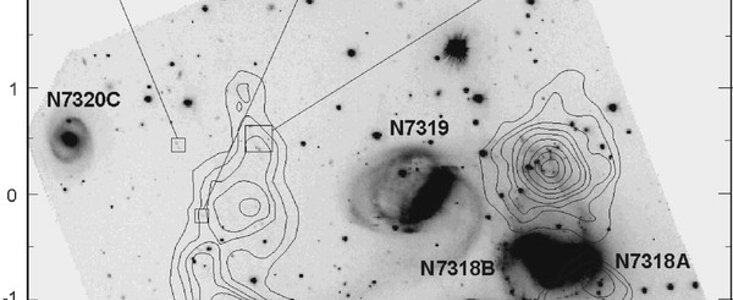Orphan HII Regions Near Stephan's Quintet
12 Abril 2004
A team of Brazilian and French astronomers led by C. Mendes de Oliveira has discovered four surprisingly metal-rich HII regions and associated clusters of hot young stars in an otherwise empty region of intergalactic space near the galaxy group called Stephan's Quintet. This collection of interacting galaxies (which lies about 280 million light-years away from us) is spreading clouds of gas and newborn stars across space. The newly discovered HII regions lie more than 80,000 light-years away from the center of action. Their relative youth and lack of apparent connection to the star-forming regions in the nearby quintet of galaxies raise questions about the sequence of events leading to their formation.
A team of Brazilian and French astronomers led by C. Mendes de Oliveira has discovered four surprisingly metal-rich HII regions and associated clusters of hot young stars in an otherwise empty region of intergalactic space near the galaxy group called Stephan's Quintet. This collection of interacting galaxies (which lies about 280 million light-years away from us) is spreading clouds of gas and newborn stars across space. The newly discovered HII regions lie more than 80,000 light-years away from the center of action. Their relative youth and lack of apparent connection to the star-forming regions in the nearby quintet of galaxies raise questions about the sequence of events leading to their formation.
To explore the dynamics of the “orphan” HII regions in more detail, the science team used the Gemini Multi-Object Spectrograph on the Gemini North Telescope to image Stephan's Quintet (Figure 1) and obtained spectra of several objects in the field. By measuring the heliocentric velocities of the intergalactic HII regions (that is, their velocities with respect to the Sun), GMOS data show that these regions lie at about the same distance from us as Stephan's Quintet. The four young stellar clusters corresponding to these intergalactic HII regions are shown in Figure 1. They exist within a large neutral hydrogen plume that runs across the field of view.
The clusters of young stars lighting up the HII regions have combined masses similar to proto-globular clusters found at other galactic merger sites as well as in Stephan's Quintet. The intergalactic material, seen in the large tail of neutral hydrogen gas, most likely corresponds to remnants torn free during recent interactions in Stephan's Quintet.
Measurements of the amount of oxygen in the newly discovered HII regions (from optical nebular emission lines in spectra taken by GMOS) indicate levels that are similar to solar oxygen abundances. This means that the intergalactic matter from which the young star clusters formed had already been well enriched by material (like oxygen) from earlier generations of massive stars (a process that most likely took place when the gas was still part of the galaxies in Stephan's Quintet).
More details can be found in the paper “A Nursery of Young Objects: Intergalactic HII Regions in Stephan's Quintet”, by C. Mendes de Oliveira, E. S. Cypriano, L. Sodré and C. Balkowski in The Astrophysical Journal, vol. 605, 2004 April 10 issue.


